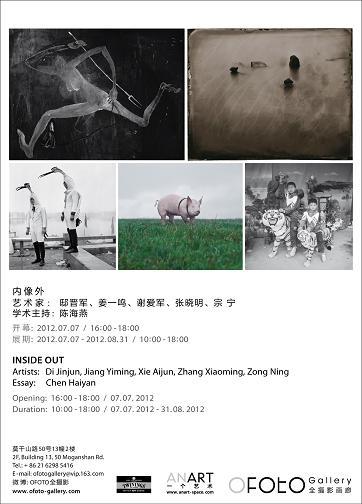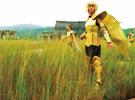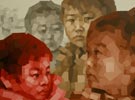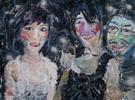
展览时间:2012-07-07 ~ 2012-08-31
展览地点:全摄影画廊
学术主持:陈海燕
参展艺术家:邸晋军、姜一鸣、谢爱军、张晓明、宗宁
开幕时间:2012-07-07 16:00~18:00
展览介绍:
内像外
对于摄影群展,手中仍然只有文字作符码,评论该如何品论得当?或者可以在纷繁富饶的艺术个性中找寻出一根主线来串构和结构?
当产生这样的困顿时,显然我陷入了内像的外化求助,当然救助对象没有一个明确的指向,也不需要真正意义上的解惑与释道,答案总是可或不可,二元的定论,还有端点之间的无限,因此开篇的问题不过只是“内”执意要外显,而“内”的眩惑仍如”外”的眩惑一般。
“像,似也。” ——《说文》,本意是相貌相似,亦涵有仿效、模拟、依随,立像……
立题为“内像外”,不过虚妄着想要将此次群展的五位摄影艺术家的作品作一次人为的同构。
邸晋军火棉胶玻璃湿版原片的正像处理,意在坚持用古老的摄影成像技术达到其内像的外显,内像外的,是藉由湿版术对时间、空间和技术的制约与限定,背弃现代摄影术提供的数码方式的随意和便捷,将易于泛滥的“外”皈依本质的“内”。
姜一鸣的《六道》主题,是佛教轮回宗义在图像上的自述,是“内”模拟出的“外”,视觉空混出“外”的形象。
谢爱军将日常生活的正常轻巧地拉开距离,组合出了非常态,是“内”与“外”的相似又背离,内像外?还是外像内?没有了答案。
张晓明的内像外更像是一种视觉仪式,戏剧性地描摹出了充满张力的静帧画面,貌似纪实,其实仍是“内”与“外”的表象相似,和内在冲突。
而宗宁,显然将多重的语汇(实物、绘画与摄影)平面着拼贴出一个错乱怪诞的空间,犹如塞尚绘画作品中呈现的焊接感。这是“内”与“外”的统调立像,不讳平面与立体,晦涩了“内”与“外”的关系。
这样的品论,如何能被你解读?还是我手中拥有的符码同样在试图调配和绘制着一种意象?!并且想和他们一样,渴望被认同,又渴望不曾被认同,正如福楼拜所说:“我对你就像我以前对那些最钟爱的人一样,我把口袋底翻给他们看,从口袋底扬起辛辣刺鼻的尘土使他窒息。”
每个人都像一个封闭的城堡,接受外来的信息亦带着个人的喜好,这样的内外关系需要解码的密本,人们的手中都会有一本,但也许它并不能成为万能的解码工具,因而,“内”与“外”总是吊诡着。
这里呈现的当然不能是完全意义上的一种阐释,正如他们展示的作品一样,只是一个切片,利用摄诱,组合出一个意象群落,供你观瞻,供你知晓,即使历史无论演进得如何精彩,也总有更多的秘密无法被彻底地拆解,而来自于神秘主义的力量总让一些人努力要将这些“内”立像于“外”,并借创作的作品从空蒙中安静地显像出来。
陈海燕
INSIDE OUT
Is it possible to write a good critical article about a group photography exhibition, with only words at hand? Can I, perhaps, find something common among all the highly individual artists in this exhibition?
When confronted with such questions, I started to look at the external representations of “inside images”, which don’t have any clear subject or true interpretation. The answer to my questions in the opening paragraph can always be “yes” or “no”, but we shall not neglect endless possibilities between these two endpoints. So the essence of these questions is: the “inside” wants to be “out”, and they are both confused.
According to “Shuo Wen” (Explaining and Analyzing Characters), one of the earliest Chinese dictionaries, the Chinese character “Xiang” (image) originally means resemblance, and now can also mean imitation, copying, following, forming images, etc.
The title “INSIDE OUT” is my personal attempts to unify the five photographers’ works for this exhibition.
Di Jinjun insists on using the originals of the very ancient wet plate collodion process, to create external representations of “inside”, which would mean that he has to be confined to strict timing, limited space and complicating techniques to discard the overflow of more easy and convenient digital photography.
The subject of Jiang Yiming’s works, “Six Ways”, is a visual self-narration of Buddhist transmigration.
Xie Aijun’s photos depict our daily life in an original and unconventional way. In his works, “inside” and “outside” seem to be very similar, yet vastly differently. No one can tell the true nature of such representations.
Zhang Xiaoming’s works can be considered a visual ceremony. Filled with tension, his highly dramatic photos seem documentary in nature. But they, in fact, represent the similarities and conflicts between “inside” and “outside”.
Zong Ning’s works combine a variety of visual languages (object, painting and photograph) in a 2D way, creating a magical and enigmatic space, similar to the “welding effect” in Paul Cézanne’s paintings. His works harmonizes “inside” and “outside” and “two-dimension” and “three-dimension”, blurring the boundary between “inside” and “outside”.
I am wondering what my readers would think of my interpretation above. Is it possible that I have been trying to create some sort of images with my words? And, is it possible that, similar to the artists in the show, I yearn for recognition and loathe it at the same time? As Gustave Flaubert said: “I treat you like those who I loved. I turn the pocket inside out and the pungent dust rising from the pocket bottom suffocates him.”
Everyone is a closed book, accepting information that he or she wants. Thus, for each individual, we need a decoding book to understand the relationship of “inside” and “outside”. And since no one’s decoding book is the same, there has always been a paradoxical relationship between “inside” and “outside”.
This article is by no means a complete interpretation of all the works in this exhibition, as the exhibits here are only a selected part of the artists’ creations. Similarly, my article presents only a fraction of my mind. Whatever dramatically happened in the history, there would always be secrets un-deciphered. Nevertheless, mysticism urges people attempt to reveal the “inside” “outside” and by the art creations it appears gracefully from the mystery.
Chen Haiyan
- 2012-06-30 ~ 2012-08-05何去何从——龚新如个展
- 2012-06-30 ~ 2012-08-15“7”——姜晓春个展
- 2012-06-22 ~ 2012-07-22瞬间——马丁·克里马斯个展
- 2012-06-30 ~ 2012-07-31“无差别”当代艺术展
- 2012-07-21 ~ 2012-08-21叙事句——当代艺术邀请展
- 2012-06-29 ~ 2012-07-29内功
- 2012-07-01 ~ 2012-07-31没什么画...
- 2012-06-21 ~ 2012-07-22人是主要的
- 2012-06-24 ~ 2012-07-24苦瓜家园——2012吴冠中师生作品展
- 2012-06-16 ~ 2012-07-28齐谐山志——王天璇个展




